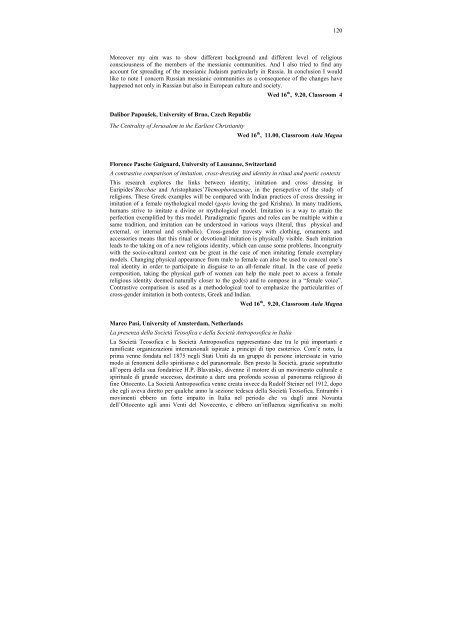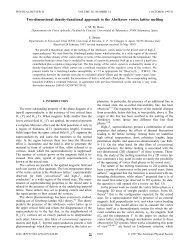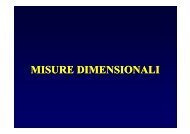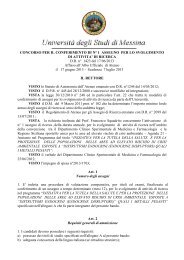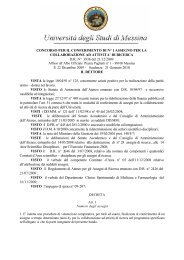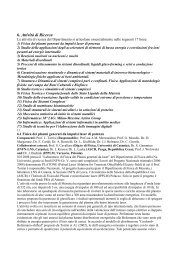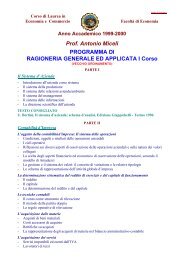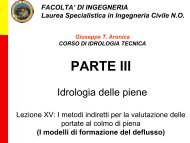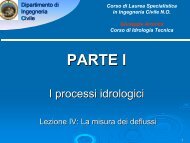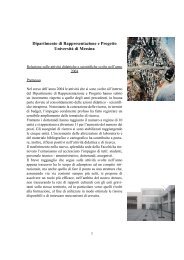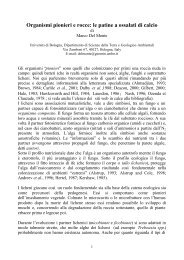PROGRAMME AND ABSTRACTS - Università degli Studi di Messina
PROGRAMME AND ABSTRACTS - Università degli Studi di Messina
PROGRAMME AND ABSTRACTS - Università degli Studi di Messina
Create successful ePaper yourself
Turn your PDF publications into a flip-book with our unique Google optimized e-Paper software.
120<br />
Moreover my aim was to show <strong>di</strong>fferent background and <strong>di</strong>fferent level of religious<br />
consciousness of the members of the messianic communities. And I also tried to find any<br />
account for sprea<strong>di</strong>ng of the messianic Judaism particularly in Russia. In conclusion I would<br />
like to note I concern Russian messianic communities as a consequence of the changes have<br />
happened not only in Russian but also in European culture and society.<br />
Dalibor Papoušek, University of Brno, Czech Republic<br />
The Centrality of Jerusalem in the Earliest Christianity<br />
Florence Pasche Guignard, University of Lausanne, Switzerland<br />
Wed 16 th , 9.20, Classroom 4<br />
Wed 16 th , 11.00, Classroom Aula Magna<br />
A contrastive comparison of imitation, cross-dressing and identity in ritual and poetic contexts<br />
This research explores the links between identity, imitation and cross dressing in<br />
Euripides’Bacchae and Aristophanes’Themophoriazusae, in the persepctive of the study of<br />
religions. These Greek examples will be compared with In<strong>di</strong>an practices of cross dressing in<br />
imitation of a female mythological model (gopis loving the god Krishna). In many tra<strong>di</strong>tions,<br />
humans strive to imitate a <strong>di</strong>vine or mythological model. Imitation is a way to attain the<br />
perfection exemplified by this model. Para<strong>di</strong>gmatic figures and roles can be multiple within a<br />
same tra<strong>di</strong>tion, and imitation can be understood in various ways (literal, thus physical and<br />
external, or internal and symbolic). Cross-gender travesty with clothing, ornaments and<br />
accessories means that this ritual or devotional imitation is physically visible. Such imitation<br />
leads to the taking on of a new religious identity, which can cause some problems. Incongruity<br />
with the socio-cultural context can be great in the case of men imitating female exemplary<br />
models. Changing physical appearance from male to female can also be used to conceal one’s<br />
real identity in order to participate in <strong>di</strong>sguise to an all-female ritual. In the case of poetic<br />
composition, taking the physical garb of women can help the male poet to access a female<br />
religious identity deemed naturally closer to the god(s) and to compose in a “female voice”.<br />
Contrastive comparison is used as a methodological tool to emphasize the particularities of<br />
cross-gender imitation in both contexts, Greek and In<strong>di</strong>an.<br />
Marco Pasi, University of Amsterdam, Netherlands<br />
Wed 16 th , 9.20, Classroom Aula Magna<br />
La presenza della Società Teosofica e della Società Antroposofica in Italia<br />
La Società Teosofica e la Società Antroposofica rappresentano due tra le più importanti e<br />
ramificate organizzazioni internazionali ispirate a principi <strong>di</strong> tipo esoterico. Com’è noto, la<br />
prima venne fondata nel 1875 negli Stati Uniti da un gruppo <strong>di</strong> persone interessate in vario<br />
modo ai fenomeni dello spiritismo e del paranormale. Ben presto la Società, grazie soprattutto<br />
all’opera della sua fondatrice H.P. Blavatsky, <strong>di</strong>venne il motore <strong>di</strong> un movimento culturale e<br />
spirituale <strong>di</strong> grande successo, destinato a dare una profonda scossa al panorama religioso <strong>di</strong><br />
fine Ottocento. La Società Antroposofica venne creata invece da Rudolf Steiner nel 1912, dopo<br />
che egli aveva <strong>di</strong>retto per qualche anno la sezione tedesca della Società Teosofica. Entrambi i<br />
movimenti ebbero un forte impatto in Italia nel periodo che va dagli anni Novanta<br />
dell’Ottocento agli anni Venti del Novecento, e ebbero un’influenza significativa su molti


